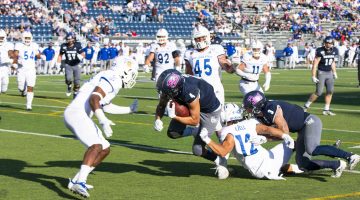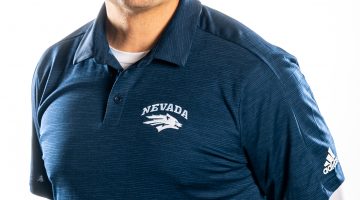
Photo courtesy of Emmet Farnan/The Observer
Notre Dame receiver CJ Sanders (3) celebrates with teammates
after scoring a touchdown in the second quarter at Notre Dame
Stadium on Saturday, Sept. 10. The Irish scored 25 straight points
in the second quarter.
By Neil Patrick Healy
NEVADA PLAYED NOTRE DAME LAST WEEKEND and I had the privilege to cover it. As someone who grew up in an Irish-Catholic h o u s e h o l d , growing up a Notre Dame fan was a family heirloom passed down from one generation to the next. Out of all sights and sounds I saw while walking around the legendary Notre Dame campus, there was one that stuck out to me because it felt so familiar.
I was standing at the base of the Knute Rockne statue in front of Notre Dame Stadium waiting for my Uber to the bus station. The championship banners were rippling from the soft breeze that blew through the tunnel to the field. There was a father playing catch with his son on the quad in front of Touchdown Jesus. It was the perfect afternoon that was on every university catalog or in the most memorable scenes in “Rudy.”
My driver picked me up and we started talking. We talked about the game, the campus, the weather and the city. When I told him I was reporting on the game and was in the press box, his eyes lit up with excitement.
“I helped build that!” he said. “I work in construction and helped put in the ceiling tiles.”
It turned out he grew up in South Bend and naturally grew up going to Notre Dame games. He worked in construction until the economy crashed in the late 2000s and was on unemployment looking for work when he began tiling roofs and operating the press in one of the factories. After doing this for a few years, the opportunity to work on the renovations to the stadium came up and he volunteered to be part of the detail.
“They asked who wanted to work on Notre Dame’s stadium and I said, ‘Where do I sign up?’”

Photo courtesy of Emmet Farnan/The Observer Notre Dame quarterback Deshone Kizer (14) prepares to take the snap against Nevada at Notre Dame Stadium on Sept. 10. Kizer combined for three total touchdowns against the Wolf Pack.
After he made it clear to me that all the workers were union guys, he showed me his Notre Dame leprechaun tattoo on his shoulder and told me how excited he was when he gave a ride to Notre Dame quarterback Deshone Kizer. As I kept talking to this guy, I couldn’t help but laugh to myself about how stereotypical this dude’s life was and how connected I felt to it at the same time.
His work struggle describes the entire Rust Belt of America and how it has had to adapt to the new global economy. His infatuation with Notre Dame and how proud he was that he got to put in the ceiling tiles in the press box of Notre Dame Stadium reflected how my family and the rest of the fan base view the school and the team. This 20-minute drive summed up the weekend because the whole time I felt comfortable. Easily the best Uber ride I’ve ever taken.
ROGER GOODELL CAME OUT AGAINST COLIN KAEPERNICK AND HIS PROTEST LAST WEEK in an email interview with the Associated Press, and it made me seriously question if Goodell has any sense of self-awareness.
“I don’t necessarily agree with what he is doing,” Goodell said. “I support our players when they want to see change in society, and we don’t live in a perfect society. On the other hand, we believe very strongly in patriotism in the NFL. I personally believe very strongly in that.”
Of anyone on the planet, I think Goodell is one of the last people who should be coming out for patriotism. You know all those pre-game ceremonies with the solders holding the American flag the size of the entire football field? Some NFL teams actually charged the military money for the ability to do this!
According to a report from Christopher Baxter and Jonathan Salant of NJ.com, the Department of Defense paid 14 different teams a total of $5.4 million over a four-year span for the displays honoring the military. With the rising tension in the league and among its fan base about this string of protests, the NFL shouldn’t be waiving the flag and campaigning for patriotism when this very same league charged the military money for displays of patriotism.
COLLEGE BASKETBALL’S GRADUATE-TRANSFER RULE CAME UNDER FIRE when ESPN released an article illustrating coaches’ displeasure with it. For those who don’t know, the graduate-transfer rule basically states that if a player earns their degree before they complete their athletic eligibility, they can transfer to another school without having to sit out a year as long as that school carries a graduate program that the player’s school doesn’t offer.
In the article, there were examples of how mid-major coaches would lose their best players to big-time programs, or how bigger programs are forced to take in these players in fear of their competition doing so. As I was reading the article, I couldn’t help but laugh at the coaches’ feelings toward the rule.
In college basketball and college sports in general, the coaches and athletic directors have a vast majority of the power. As soon as the athlete signs their letter of intent, they sign away their rights to receive money for their play while the schools and the NCAA make millions off them, they can’t gain other forms of employment while they’re on scholarship due to time constraints or team rules, and if they decide to transfer to another school they have to sit out a year and lose a year of eligibility. Even when the athlete elects to lose that year of eligibility, the school can still dictate which schools they can or cannot transfer to. The construct leans in favor of the coaches so much it’s laughable. So when coaches come out and verbalize their displeasure for the one rule in favor of the athletes, it really shows how power-hungry the coaches and athletic directors are.
One coach even said that he would sometimes encourage his players to not take as many classes so they wouldn’t be able to graduate on time and then transfer to another school.
“What kid is going to argue and want to take more classes?” one unnamed mid-major coach said. “There aren’t many.”
When you have coaches deliberately influencing their players to not graduate on time, it shows the lunacy of the mentality of those in charge. It would be one thing if the playing field were even and the construct weren’t so unbalanced, but complaining about the one rule in favor of the players just makes you look petty.
Neil Patrick Healy can be reached at neil@sagebrush.unr. edu and on Twitter @NP_Healy.












